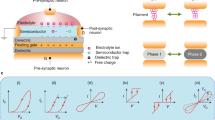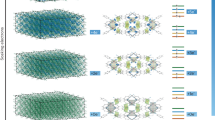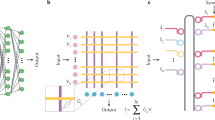Abstract
Neuromorphic computing requires electronic systems that can perform massively parallel computational tasks with low energy consumption. Such systems have traditionally been based on complementary metal–oxide–semiconductor circuits, but further advances in computational performance will probably require devices that can offer high-order complexity combined with area and energy efficiency. Halide perovskites can handle both ions and electronic charges, and could be used to create adaptive computing systems based on intrinsic device dynamics. The materials also offer exotic switching phenomena, providing opportunities for multimodal systems. Here we explore the development of neuromorphic hardware systems based on halide perovskites. We examine how devices based on these materials can serve as synapses and neurons, and can be used in neuromorphic computing networks. We also consider the challenges involved in developing practical perovskite neuromorphic systems, and highlight how these systems could augment and complement digital circuits.
This is a preview of subscription content, access via your institution
Access options
Access Nature and 54 other Nature Portfolio journals
Get Nature+, our best-value online-access subscription
$29.99 / 30 days
cancel any time
Subscribe to this journal
Receive 12 digital issues and online access to articles
$119.00 per year
only $9.92 per issue
Buy this article
- Purchase on Springer Link
- Instant access to full article PDF
Prices may be subject to local taxes which are calculated during checkout




Similar content being viewed by others
Data availability
The data that support the findings of this study are available from the corresponding authors.
References
Mead, C. Neuromorphic electronic systems. Proc. IEEE 78, 1629–1636 (1990). This paper reports the term ‘neuromorphic’.
Abbott, L. F. & Regehr, W. G. Synaptic computation. Nature 431, 796–803 (2004).
Furber, S. B., Galluppi, F., Temple, S. & Plana, L. A. The SpiNNaker Project. Proc. IEEE 102, 652–665 (2014).
Tuma, T., Pantazi, A., Le Gallo, M., Sebastian, A. & Eleftheriou, E. Stochastic phase-change neurons. Nat. Nanotechnol. 11, 693–699 (2016).
Sebastian, A., le Gallo, M., Khaddam-Aljameh, R. & Eleftheriou, E. Memory devices and applications for in-memory computing. Nat. Nanotechnol. 15, 529–544 (2020).
Koelmans, W. et al. Projected phase-change memory devices. Nat. Commun. 6, 8181 (2015).
van de Burgt, Y. et al. A non-volatile organic electrochemical device as a low-voltage artificial synapse for neuromorphic computing. Nat. Mater. 16, 414–418 (2017).
Rzeszut, P. et al. Multi-state MRAM cells for hardware neuromorphic computing. Sci. Rep. 12, 7178 (2022).
Strukov, D. B., Snider, G. S., Stewart, D. R. & Williams, R. S. The missing memristor found. Nature 453, 80–83 (2008). This paper reports the fabrication of a memristor.
Yang, J. J., Strukov, D. B. & Stewart, D. R. Memristive devices for computing. Nat. Nanotechnol. 8, 13–24 (2013).
Prezioso, M. et al. Training and operation of an integrated neuromorphic network based on metal–oxide memristors. Nature 521, 61–64 (2015).
Danial, L. et al. Two-terminal floating-gate transistors with a low-power memristive operation mode for analogue neuromorphic computing. Nat. Electron. 2, 596–605 (2019).
Sangwan, V. K. & Hersam, M. C. Neuromorphic nanoelectronic materials. Nat. Nanotechnol. 15, 517–528 (2020).
Yi, W. et al. Biological plausibility and stochasticity in scalable VO2 active memristor neurons. Nat. Commun. 9, 4661 (2018).
Oh, S. et al. Energy-efficient Mott activation neuron for full-hardware implementation of neural networks. Nat. Nanotechnol. 16, 680–687 (2021).
Boyn, S. et al. Learning through ferroelectric domain dynamics in solid-state synapses. Nat. Commun. 8, 14736 (2017).
Shi, J. et al. A correlated nickelate synaptic transistor. Nat. Commun. 4, 2676 (2013).
Mou, X. et al. Analog memristive synapse based on topotactic phase transition for high-performance neuromorphic computing and neural network pruning. Sci. Adv. 7, eabh0648 (2021).
Zhang, H. T. et al. Perovskite neural trees. Nat. Commun. 11, 2245 (2020).
Ryu, H. & Kim, S. Implementation of a reservoir computing system using the short-term effects of Pt/HfO2/TaOx/TiN memristors with self-rectification. Chaos Solitons Fractals 150, 111223 (2021).
Xu, R. et al. Vertical MoS2 double-layer memristor with electrochemical metallization as an atomic-scale synapse with switching thresholds approaching 100 mV. Nano Lett. 19, 2411–2417 (2019).
Bessonov, A. A. et al. Layered memristive and memcapacitive switches for printable electronics. Nat. Mater. 14, 199–204 (2015). This is a paper on printed memristors.
Zhang, F. et al. Electric-field induced structural transition in vertical MoTe2- and Mo1–xWxTe2-based resistive memories. Nat. Mater. 18, 55–61 (2019).
Seo, S. et al. Artificial optic–neural synapse for colored and color-mixed pattern recognition. Nat. Commun. 9, 5106 (2018).
Shi, Y. et al. Electronic synapses made of layered two-dimensional materials. Nat. Electron. 1, 458–465 (2018).
Sharbati, M. T. et al. Low-power, electrochemically tunable graphene synapses for neuromorphic computing. Adv. Mater. 30, 1802353 (2018).
Kireev, D. et al. Metaplastic and energy-efficient biocompatible graphene artificial synaptic transistors for enhanced accuracy neuromorphic computing. Nat. Commun. 13, 4386 (2022).
Abdollahramezani, S. et al. Electrically driven reprogrammable phase-change metasurface reaching 80% efficiency. Nat. Commun. 13, 1696 (2022).
Leydecker, T. et al. Flexible non-volatile optical memory thin-film transistor device with over 256 distinct levels based on an organic bicomponent blend. Nat. Nanotechnol. 11, 769–775 (2016).
Lee, C. et al. A reconfigurable binary/ternary logic conversion-in-memory based on drain-aligned floating-gate heterojunction transistors. Nat. Commun. 14, 3757 (2023).
Sarkar, T. et al. An organic artificial spiking neuron for in situ neuromorphic sensing and biointerfacing. Nat. Electron. 5, 774–783 (2022).
Harikesh, P. C. et al. Ion-tunable antiambipolarity in mixed ion–electron conducting polymers enables biorealistic organic electrochemical neurons. Nat. Mater. 22, 242–248 (2023).
van de Burgt, Y., Melianas, A., Keene, S. T., Malliaras, G. & Salleo, A. Organic electronics for neuromorphic computing. Nat. Electron. 1, 386–397 (2018). This is a review paper about the prospect of organic semiconductors for neuromorphic computing.
Hao, J. et al. Low-energy room-temperature optical switching in mixed-dimensionality nanoscale perovskite heterojunctions. Sci. Adv. 7, eabf1959 (2021).
Raifuku, I. et al. Halide perovskite for low-power consumption neuromorphic devices. EcoMat 3, e12142 (2021).
Hao, D., Yang, Z., Huang, J. L. & Shan, F. K. Recent developments of optoelectronic synaptic devices based on metal halide perovskites. Adv. Funct. Mater. 33, 2211467 (2023).
Hong, X., Liu, X., Liao, L. & Zou, X. Review on metal halide perovskite-based optoelectronic synapses. Photon. Res. 11, 787–807 (2023).
Satapathi, S., Raj, K., Yukta & Afroz, M. A. Halide-perovskite-based memristor devices and their application in neuromorphic computing. Phys. Rev. Appl. 18, 017001 (2022).
Chen, S. & Huang, J. Recent advances in synaptic devices based on halide perovskite. ACS Appl. Electron. Mater. 2, 1815–1825 (2020).
Li, W. et al. Chemically diverse and multifunctional hybrid organic–inorganic perovskites. Nat. Rev. Mater. 2, 16099 (2017). This is a paper on the multifunctional properties of halide perovskites.
Chen, B., Rudd, P. N., Yang, S., Yuan, Y. & Huang, J. Imperfections and their passivation in halide perovskite solar cells. Chem. Soc. Rev. 48, 3842–3867 (2019). This is a paper on the different types of defect present in halide perovskites.
Tress, W. Metal halide perovskites as mixed electronic−ionic conductors: challenges and opportunities—from hysteresis to memristivity. J. Phys. Chem. Lett. 8, 3106–3114 (2017). This is a paper on the opportunities arising from combined electronic and ionic conductivities in perovskites.
John, R. A. et al. Halide perovskite memristors as flexible and reconfigurable physical unclonable functions. Nat. Commun. 12, 3681 (2021).
Lin, G. et al. An organic−inorganic hybrid perovskite logic gate for better computing. J. Mater. Chem. C 3, 10793–10798 (2015).
Zhou, F. et al. Low-voltage, optoelectronic CH3NH3PbI3-xClx memory with integrated sensing and logic operations. Adv. Funct. Mater. 28, 1800080 (2018).
Abbott, L. F. & Nelson, S. B. Synaptic plasticity: taming the beast. Nat. Neurosci. 3, 1178–1183 (2000).
Ren, Z. Y. et al. Threshold-tunable, spike-rate-dependent plasticity originating from interfacial proton gating for pattern learning and memory. ACS Appl. Mater. Interfaces 12, 7833–7839 (2020).
Fang, Y., Zhai, S., Chu, L. & Zhong, J. Advances in halide perovskite memristor from lead-based to lead-free materials. ACS Appl. Mater. Interfaces 13, 17141–17157 (2021).
Yoo, E. J. et al. Resistive switching behavior in organic–inorganic hybrid CH3NH3PbI3−xClx perovskite for resistive random access memory devices. Adv. Mater. 27, 61706175 (2015). This is a paper on the application of halide perovskites in memory devices.
Xu, W. et al. Organometal halide perovskite artificial synapses. Adv. Mater. 28, 5916–5922 (2016).
Harikesh, P. C. et al. Cubic NaSbS2 as an ionic–electronic coupled semiconductor for switchable photovoltaic and neuromorphic device applications. Adv. Mater. 32, 1906976 (2020).
Zhang, C. et al. Conversion of invisible metal–organic frameworks to luminescent perovskite nanocrystals for confidential information encryption and decryption. Nat. Commun. 8, 1138 (2017).
Kim, S.-I. et al. Dimensionality dependent plasticity in halide perovskite artificial synapses for neuromorphic computing. Adv. Electron. Mater. 5, 1900008 (2019).
Ma, F. et al. Optoelectronic perovskite synapses for neuromorphic computing. Adv. Funct. Mater. 30, 1908901 (2020).
Liu, S. et al. Solution-processed synaptic memristors based on halide perovskite nanocrystals. J. Phys. Chem. Lett. 13, 10994–11000 (2022).
Park, Y. & Lee, J.-S. Metal halide perovskite-based memristors for emerging memory applications. J. Phys. Chem. Lett. 13, 5638–5647 (2022).
Xiao, Z. & Huang, J. Energy‐efficient hybrid perovskite memristors and synaptic devices. Adv. Electron. Mater. 2, 1600100 (2016).
Lee, S. et al. Tailored 2D/3D halide perovskite heterointerface for substantially enhanced endurance in conducting bridge resistive switching memory. ACS Appl. Mater. Interfaces 12, 17039–17045 (2020).
John, R. A. et al. Ionotronic halide perovskite drift‐diffusive synapses for low‐power neuromorphic computation. Adv. Mater. 30, 1805454 (2018).
Tian, H. et al. Extremely low operating current resistive memory based on exfoliated 2D perovskite single crystals for neuromorphic computing. ACS Nano 11, 12247–12256 (2017).
Cai, Y. et al. Van der Waals ferroelectric halide perovskite artificial synapse. Phys. Rev. Appl. 18, 014014 (2022).
John, R. A. et al. Reconfigurable halide perovskite nanocrystal memristors for neuromorphic computing. Nat. Commun. 13, 2074 (2022).
Li, Y. et al. Transparent and flexible inorganic perovskite photonic artificial synapses with dual-mode operation. Adv. Funct. Mater. 31, 2008259 (2021).
Lee, K. et al. Retina-inspired structurally tunable synaptic perovskite nanocones. Adv. Funct. Mater. 31, 2105596 (2021).
John, R. A. et al. Ionic–electronic halide perovskite memdiodes enabling neuromorphic computing with a second-order complexity. Sci. Adv. 8, eade0072 (2022).
Zhu, X. & Lu, W. D. Optogenetics-inspired tunable synaptic functions in memristors. ACS Nano 12, 1242–1249 (2018).
Sun, Y. et al. Photoelectric synaptic plasticity realized by 2D perovskite. Adv. Funct. Mater. 29, 1902538 (2019).
Chen, Y., Chu, Y., Wu, X., Ou-Yang, W. & Huang, J. High-performance inorganic perovskite quantum dot–organic semiconductor hybrid phototransistors. Adv. Mater. 29, 1704062 (2017).
Zhu, Q.-B. et al. A flexible ultrasensitive optoelectronic sensor array for neuromorphic vision systems. Nat. Commun. 12, 1798 (2021).
Vijjapu, M. T. et al. A flexible capacitive photoreceptor for the biomimetic retina. Light Sci. Appl. 11, 3 (2022).
Yang, J. et al. A perovskite memristor with large dynamic space for analog-encoded image recognition. ACS Nano 16, 21324–21333 (2022).
Rivnay, J. et al. Organic electrochemical transistors. Nat. Rev. Mater. 3, 17086 (2018).
Si, M. et al. A ferroelectric semiconductor field-effect transistor. Nat. Electron. 2, 580–586 (2019).
Jeong, B., Veith, L., Smolders, T. J. A. M., Wolf, M. J. & Asadi, K. Room-temperature halide perovskite field-effect transistors by ion transport mitigation. Adv. Mater. 33, 2100486 (2021).
Jeong, B., Gkoupidenis, P. & Asadi, K. Solution-processed perovskite field-effect transistor artificial synapses. Adv. Mater. 33, 2104034 (2021).
Wang, Y. et al. Photonic synapses based on inorganic perovskite quantum dots for neuromorphic computing. Adv. Mater. 30, 1802883 (2018).
Jeon, Y.-R. et al. Photo-synaptic properties of CH3NH3Pb1−xMnxBr2x+1 hybrid perovskite thin film-based artificial synapse. Ceram. Int. 49, 11140–11148 (2023).
Wang, K. et al. Light-stimulated synaptic transistors fabricated by a facile solution process based on inorganic perovskite quantum dots and organic semiconductors. Small 15, 1900010 (2019).
Hao, D., Zhang, J., Dai, S., Zhang, J. & Huang, J. Perovskite/organic semiconductor-based photonic synaptic transistor for artificial visual system. ACS Appl. Mater. Interfaces 12, 39487–39495 (2020).
Yin, L. et al. Optically stimulated synaptic devices based on the hybrid structure of silicon nanomembrane and perovskite. Nano Lett. 20, 3378–3387 (2020).
Wang, R. et al. Artificial synapses based on lead-free perovskite floating-gate organic field-effect transistors for supervised and unsupervised learning. ACS Appl. Mater. Interfaces 13, 43144–43154 (2021).
Liang, X., Luo, Y., Pei, Y., Wang, M. & Liu, C. Multimode transistors and neural networks based on ion-dynamic capacitance. Nat. Electron. 5, 859–869 (2022).
Roy, K., Jaiswal, A. & Panda, P. Towards spike-based machine intelligence with neuromorphic computing. Nature 575, 607–617 (2019).
Mao, J.-Y. et al. Lead-free monocrystalline perovskite resistive switching device for temporal information processing. Nano Energy 71, 104616 (2020).
Chen, L.-W. et al. Highly uniform all-vacuum-deposited inorganic perovskite artificial synapses for reservoir computing. Adv. Intell. Syst. 3, 2000196 (2021).
Yang, J.-Q. et al. Leaky integrate-and-fire neurons based on perovskite memristor for spiking neural networks. Nano Energy 74, 104828 (2020).
Chen, Q. et al. Switchable perovskite photovoltaic sensors for bioinspired adaptive machine vision. Adv. Intell. Syst. 2, 2000122 (2020).
Hong, S. et al. Sensory adaptation and neuromorphic phototransistors based on CsPb(Br1−xIx)3 perovskite and MoS2 hybrid structure. ACS Nano 14, 9796–9806 (2020).
John, R. A. et al. Diffusive and drift halide perovskite memristive barristors as nociceptive and synaptic emulators for neuromorphic computing. Adv. Mater. 33, 2007851 (2021).
Shao, H. et al. A reconfigurable optoelectronic synaptic transistor with stable Zr–CsPbI3 nanocrystals for visuomorphic computing. Adv. Mater. 35, 2208497 (2023).
Zhou, F. & Chai, Y. Near-sensor and in-sensor computing. Nat. Electron. 3, 664–671 (2020).
Cassella, E. J. et al. Binary solvent system used to fabricate fully annealing-free perovskite solar cells. Adv. Energy Mater. 13, 2203468 (2023).
Li, N. et al. Liquid medium annealing for fabricating durable perovskite solar cells with improved reproducibility. Science 373, 561–567 (2021).
Yuan, Q. et al. Thermally stable perovskite solar cells by all-vacuum deposition. ACS Appl. Mater. Interfaces 15, 772–781 (2023).
Choi, J. et al. Organic–inorganic hybrid halide perovskites for memories, transistors, and artificial synapses. Adv. Mater. 30, 1704002 (2018).
Wang, G. et al. Wafer-scale growth of large arrays of perovskite microplate crystals for functional electronics and optoelectronics. Sci. Adv. 1, e1500613 (2015).
Zhang, Y. et al. Three-dimensional perovskite nanowire array-based ultrafast resistive RAM with ultralong data retention. Sci. Adv. 7, eabg3788 (2021).
Poddar, S. et al. Down-scalable and ultra-fast memristors with ultra-high density three-dimensional arrays of perovskite quantum wires. Nano Lett. 21, 5036–5044 (2021).
Adam, G. C. et al. Memristor crossbars for analog and neuromorphic computing applications. IEEE Trans. Electron Devices 64, 16576530 (2017).
Tu, S.-K. et al. Room-temperature fabricated multilevel nonvolatile lead-free cesium halide memristors for reconfigurable in-memory computing. ACS Nano 16, 12979–12990 (2022).
Bi, E. et al. Efficient perovskite solar cell modules with high stability enabled by iodide diffusion barriers. Joule 3, 2748–2760 (2019).
Kim, I.-J., Kim, M.-K. & Lee, J.-S. Highly-scaled and fully-integrated 3-dimensional ferroelectric transistor array for hardware implementation of neural networks. Nat. Commun. 14, 504 (2023).
Ince, R., Adanır, S. S. & Sevmez, F. The inventor of electroencephalography (EEG): Hans Berger (1873–1941). Childs Nerv. Syst. 37, 2723–2724 (2021).
Chaudhary, U., Birbaumer, N. & Ramos-Murguialday, A. Brain–computer interfaces for communication and rehabilitation. Nat. Rev. Neurol. 12, 513–525 (2016).
Liu, A. et al. High-performance inorganic metal halide perovskite transistors. Nat. Electron. 5, 78–83 (2022). This paper reports a breakthrough in the field-effect mobility of perovskites.
Zhu, H. et al. High-performance hysteresis-free perovskite transistors through anion engineering. Nat. Commun. 13, 1741 (2022).
Yang, Q. et al. Ecoresorbable and bioresorbable microelectromechanical systems. Nat. Electron. 5, 526–538 (2022).
Han, W. B. et al. Ultra-stretchable and biodegradable elastomers for soft, transient electronics. Nat. Commun. 14, 2263 (2023).
Ma, X. et al. Superior photo-carrier diffusion dynamics in organic–inorganic hybrid perovskites revealed by spatiotemporal conductivity imaging. Nat. Commun. 12, 5009 (2021).
Cai, F. et al. Power-efficient combinatorial optimization using intrinsic noise in memristor Hopfield neural networks. Nat. Electron. 3, 409–418 (2020).
Kumar, S. et al. Dynamical memristors for higher-complexity neuromorphic computing. Nat. Rev. Mater. 7, 575–591 (2022).
Liu, J. et al. A bioinspired flexible neuromuscular system based thermal-annealing-free perovskite with passivation. Nat. Commun. 13, 7427 (2022).
Biliroglu, M. et al. Room-temperature superfluorescence in hybrid perovskites and its origins. Nat. Photon. 16, 324–329 (2022).
Tamarat, P. et al. The dark exciton ground state promotes photon-pair emission in individual perovskite nanocrystals. Nat. Commun. 11, 6001 (2020).
Feynman, R. P. Simulating physics with computers. Int J. Theor. Phys. 21, 467–488 (1982). This work describes the possibility of using computers emulating natural phenomena.
LeCun, Y., Bengio, Y. & Hinton, G. Deep learning. Nature 521, 436–444 (2015).
Acknowledgements
This study was supported by the Ministry of Science and ICT through the National Research Foundation, funded by the Korean Government (NRF-2021R1A2C3005401). The research work presented in this article was partially supported by the European Commission under the Horizon Europe Programme, through funding of the OASEES project (101092702).
Author information
Authors and Affiliations
Contributions
All authors conceived this work and contributed to the discussion of content. M.V. and A.R.b.M.Y. researched the data and wrote the first draft. M.K.N., R.D., F.G., T.D.A. and Y.-Y.N. revised the manuscript before submission.
Corresponding authors
Ethics declarations
Competing interests
The authors declare no competing interests.
Peer review
Peer review information
Nature Electronics thanks Hao-Wu Lin, Wentao Xu and the other, anonymous, reviewer(s) for their contribution to the peer review of this work.
Additional information
Publisher’s note Springer Nature remains neutral with regard to jurisdictional claims in published maps and institutional affiliations.
Rights and permissions
Springer Nature or its licensor (e.g. a society or other partner) holds exclusive rights to this article under a publishing agreement with the author(s) or other rightsholder(s); author self-archiving of the accepted manuscript version of this article is solely governed by the terms of such publishing agreement and applicable law.
About this article
Cite this article
Vasilopoulou, M., Mohd Yusoff, A.R.b., Chai, Y. et al. Neuromorphic computing based on halide perovskites. Nat Electron 6, 949–962 (2023). https://doi.org/10.1038/s41928-023-01082-z
Received:
Accepted:
Published:
Issue Date:
DOI: https://doi.org/10.1038/s41928-023-01082-z



